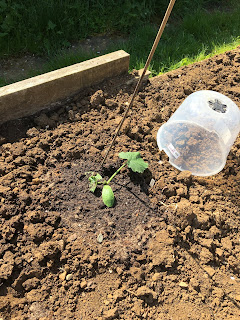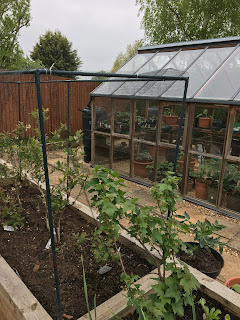Gardeners love the natural world. They love it right up to the moment when they realise they missed a cabbage white butterfly laying tiny yellow eggs on a pristine brassica leaf and now those tiny yellow eggs are hundreds of very hungry caterpillars. Or when a fat slug stuffs its face on a runner bean plant, leaving nothing but a grinning slimy trail. Or when a pigeon ignores the dandelions and goes for the pea shoots. Or a mouse carefully takes one bite out of each strawberry.
My aim is to allow lots of nature-friendly weedery at the edges of my plot but also prevent the pests from getting to my produce. Without the use of harmful chemicals.
My successes or failures in the Veg Protection Wars can be measured by either screams of despair or blissful silence from my veg patch.
Let me show you the various things I use.
Depending on the plant and on the time of year, you'll be wanting to protect against one or more of:
These green hoops and some netting provide very simple and effective protection against birds for young beans and peas. You can easily and quickly move them to where you need them. The netting is also light enough that you can just drape it over larger plants.
This is this year's brassica bed. Small brassicas are under the plastic cloches (and you can see some more under a dark green tunnel.) The green pole frame is ready for bastard butterfly netting when those cloches are too small. See further down this page.

 I have a load of these small hoops, which are very useful for throwing netting or frost fleece over.
I have a load of these small hoops, which are very useful for throwing netting or frost fleece over.
My aim is to allow lots of nature-friendly weedery at the edges of my plot but also prevent the pests from getting to my produce. Without the use of harmful chemicals.
My successes or failures in the Veg Protection Wars can be measured by either screams of despair or blissful silence from my veg patch.
Let me show you the various things I use.
Depending on the plant and on the time of year, you'll be wanting to protect against one or more of:
- frost - some things (eg spinach) are ridiculously resistant but others not
- wind
- sunburn
- slugs - the buggers will wait till you have a few lovely leaves, which you've been admiring during the day, and overnight they'll turn into locusts and take everything down to the stem
- sodding caterpillars (in other words, pretty butterflies)
- rabbits - I'm safe from these as I have raised beds and my neighbour has an efficient terrier
- mice
- birds - and different ones behave differently: blackbirds are the cheeky bastards with their unbelievable cleverness. I have watched one pick up the bottom of a net and hop inside, steal a blueberry and pick up the net again to hop out. If you have a small hole in your fruit cage, Mr Blackbird will find it. You will love blackbirds until you have blueberries. Or grapes. And anything sweet and berry-shaped.
These green hoops and some netting provide very simple and effective protection against birds for young beans and peas. You can easily and quickly move them to where you need them. The netting is also light enough that you can just drape it over larger plants.
These water-permeable tunnels are fantastic for seedlings and young plants, again protecting from birds and butterflies, as well as sunburn, while letting water and air in.
Buy the giant-sized ones for greater flexibility. They are slightly fiddly so you wouldn't be wanting to move them often, but easy to lift to tend, weed and check plants. You'd then remove them once the plants were big enough to be birdproof.
These plastic cloches are great, too. You have main section and ends and there are holes at the base to fix into the ground with metal pegs. I have a LOT of those pegs - they are fantastic and can also be used to peg down netting and frost fleece. You pierce holes in the top "reservoirs" so rain water collects and falls through.
Here you see my green hoops being useful again, this time under a plastic sheet with holes, making a temporary polytunnel. You would choose a windless day for putting this together, unless you want to create a comedy show for your neighbours. This will protect from birds, wind, sunburn, and butterflies (although it's too early in the year to worry about those yet.)
This is this year's brassica bed. Small brassicas are under the plastic cloches (and you can see some more under a dark green tunnel.) The green pole frame is ready for bastard butterfly netting when those cloches are too small. See further down this page.
This is the lid of a propagator forming a very useful instantly moveable protection for eg a young courgette plant before it makes its bid for world domination.
And here's another cover for courgettes, squashes etc. Fix in place with a cane through one of the holes.

 I have a load of these small hoops, which are very useful for throwing netting or frost fleece over.
I have a load of these small hoops, which are very useful for throwing netting or frost fleece over.
This plastic netting is brilliant for loads of things. It's supposed to be for attaching to a fence for things to climb up but here it's being used to cover salad leaves in a raised bed.
Above, I've started preparing the netting for the bastard butterflies. One huge piece of netting goes from one end to the other, over the top, with a very generous overhang on each side.
And now I've done the sides and you can see that the overlap is massive, with some ties to keep it in place. This means that the butterflies don't have a chance. You may think I'm mean to butterflies. Butterflies are gorgeous and beautiful and important, but they don't get to come anywhere near my brassicas.
Brassica cage complete for 2020.
More hoops and this is insect netting. Obviously, in this case it's not keeping insects off but at this time of year I'm not bothered about insects. This is keeping pigeons off my broad beans and to the right of the broad beans (and picture below) you can see it covering some pea shoots.
Two more sorts of wire netting in that pic above: thick green wire frames making the hoop shape and a piece of wire netting round the ends. This would work for rabbits if I had any.
Frost fleece over wire hoops. Frost fleece is wonderful - so light, so easy to put on different things.
Frost fleece over a raised bed, held in place by strips of wood.
Blackbird proof cage for blueberries. These rectangular frames are held together with a range of corners and wide supports - very easy to take to pieces and put together in a different size.
That green plastic wire keeping pigeons off pea shoots, help out of harm's way by logs.
What about slugs, I hear you ask? I use ferrous sulphate pellets, which are approved by the RSPB and RHS as they don't harm other wildlife. the ones I use (and also a gel) are certified organic.
And mice? I regret to inform you that this year I set traps amongst my pea shoots. I am happy to inform you that I didn't catch anything and my peas remained untouched. I really don't want to catch anything so I have decided that I'm not going to set any more traps and I have a cunning plan with my strawberries: I'm going to put pieces of cheese nearby and hope the mice choose the cheese. I'll keep you posted!
All the things I've used are reusable - none of it has been bought this year and I don't expect to have to buy anything more for at least a couple of years, by which time I might have to replace some of my metal cage supports and probably buy some more frost fleece as it tears quite easily.
Good luck in Veg Protection Wars - or, as I prefer to call it, your happy partnership with nature - and may the bloody cabbage whites indulge themselves on the weeds you leave at the sides of your garden and leave your brassicas for you!


















Comments
Post a Comment